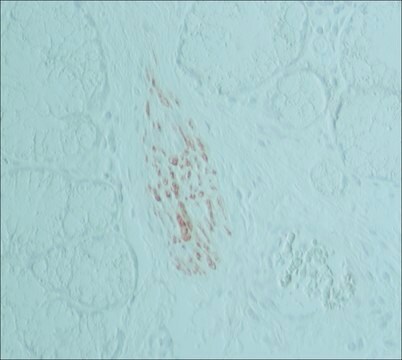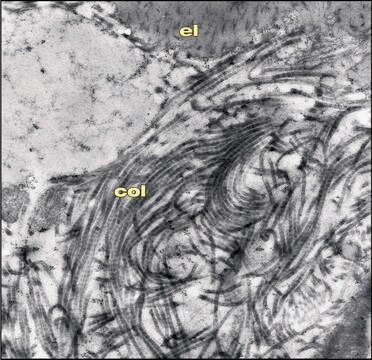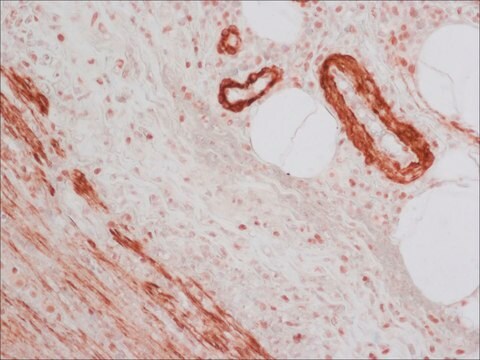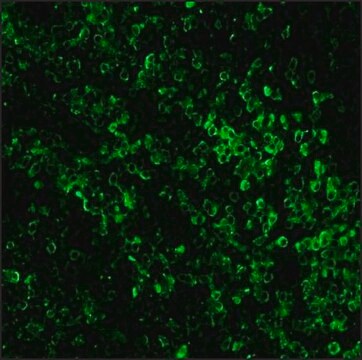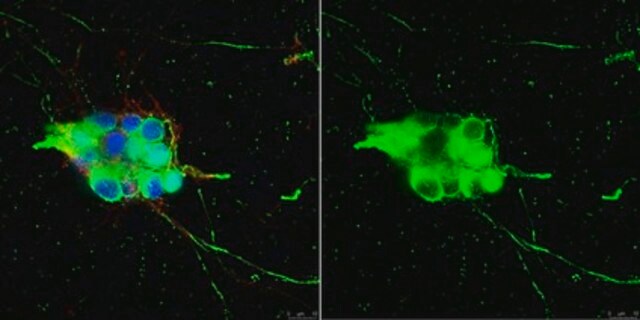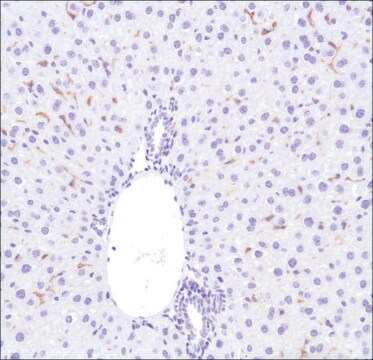C0678
Monoclonal Anti-HNK-1/N-CAM (CD57) antibody produced in mouse
clone VC1.1, ascites fluid, buffered aqueous solution
동의어(들):
Monoclonal Anti-HNK-1, Anti-CD57, Anti-N-CAM
로그인조직 및 계약 가격 보기
모든 사진(3)
About This Item
결합:
unconjugated
application:
WB
클론:
VC1.1, monoclonal
종 반응성:
mouse, rat, feline, human
citations:
17
기술:
western blot: 1:4,000 using cerebral cortex extract
추천 제품
생물학적 소스
mouse
Quality Level
결합
unconjugated
항체 형태
ascites fluid
항체 생산 유형
primary antibodies
클론
VC1.1, monoclonal
양식
buffered aqueous solution
포함
15 mM sodium azide
종 반응성
mouse, rat, feline, human
기술
western blot: 1:4,000 using cerebral cortex extract
동형
IgM
UniProt 수납 번호
배송 상태
dry ice
저장 온도
−20°C
타겟 번역 후 변형
unmodified
유전자 정보
human ... B3GAT1(27087)
mouse ... B3gat1(76898)
rat ... B3gat1(117108)
유사한 제품을 찾으십니까? 방문 제품 비교 안내
일반 설명
Monoclonal Anti-HNK-1/N-CAM (CD57) (mouse IgM isotype) is derived from the VC1.1 hybridoma produced by the fusion of mouse myeloma cells and splenocytes from immunized BALB/c mice. Human natural killer cell -1 (HNK-1), also referred as B3GAT1, NK1, CD57, LEU7, NK-1, GLCATP and GLCUATP, is mapped to human chromosome 11q25. The encoded protein belongs to the glucuronyltransferase gene family. Neural cell-adhesion molecule (N-CAM) is expressed on all neuroepithelial cells from the time of neural induction in the early embryo. It is known that the sulfated carbohydrate HNK-1 epitope is carried by several surface molecules including a proportion of N-CAM isoforms.
특이성
Recognizes the CD57/HNK-1 human myeloid cell associated surface glycoprotein. The epitope recognized is an N-linked carbohydrate which is present in a variety of glycoproteins and in some glycolipids. It is resistant to formalin fixation and paraffin embedding. VC1.1 antibody and the HNK-1 (Leu7) antibody inhibit the binding of each other. The antibody recognizes myelin associated glycoprotein in some species and a high molecular weight chondroitin sulphate proteoglycan.
5th Workshop: code no. NK 67
5th Workshop: code no. NK 67
면역원
A homogenate of cat primary visual cortex (area 17)
애플리케이션
Applications in which this antibody has been used successfully, and the associated peer-reviewed papers, are given below.
Immunohistochemistry (1 paper)
Immunohistochemistry (1 paper)
Monoclonal Anti-HNK-1/N-CAM (CD57) antibody produced in mouse has been used:
- as primary antibody for western blot analysis
- immunocytochemistry
- immunocytochemical
- immunohistological staining
생화학적/생리학적 작용
HNK1 (human natural killer-1) is referred as B3GAT1, NK1, CD57, LEU7, NK-1, GLCATP and GLCUATP. It is a member of the glucuronyltransferase gene family. Human natural killer-1 (HNK1) carbohydrate epitope is expressed on various cell adhesion molecules in the nervous system and plays a role in cell-cell and cell-substrate interactions. HNK-1 epitope stabilizes GluR2 on neuronal surface membranes and regulates cell surface stability of GluR2 by modulating the interaction with N-cadherin. It is also plays a role in cell migration and synaptic plasticity. HNK-1 epitope has been associated with the risk of metastasis. It is observed to be highly expressed in melanoma cell lines.
표적 설명
CD57/HNK-1 is expressed on a subpopulation of 15-20% of peripheral blood mononuclear cells, about 60% of NK active cells and on a subset of T cells.
면책조항
Unless otherwise stated in our catalog or other company documentation accompanying the product(s), our products are intended for research use only and are not to be used for any other purpose, which includes but is not limited to, unauthorized commercial uses, in vitro diagnostic uses, ex vivo or in vivo therapeutic uses or any type of consumption or application to humans or animals.
적합한 제품을 찾을 수 없으신가요?
당사의 제품 선택기 도구.을(를) 시도해 보세요.
Storage Class Code
10 - Combustible liquids
WGK
WGK 3
Flash Point (°F)
Not applicable
Flash Point (°C)
Not applicable
Danfang Zhang et al.
Proceedings of the National Academy of Sciences of the United States of America, 108(10), 4117-4122 (2011-03-04)
Chemotherapy-induced broad toxicities are the leading cause of the drug-induced mortality in cancer patients. Antiangiogenic drugs (ADs) in combination with chemotherapy are widely used as front-line therapy for the treatment of various human cancers. However, the beneficial mechanisms underlying combination
Neural differentiation of pluripotent mouse embryonal carcinoma cells by retinoic acid: inhibitory effect of serum
Pachernik J, et al.
Physiological Research, 54(1), 115-122 (2005)
Loss of Shp2-mediated mitogen-activated protein kinase signaling in Muller glial cells results in retinal degeneration
Cai Z, et al.
Molecular and Cellular Biology, 31(14), 2973-2983 (2011)
Ronald S Goldstein
Methods in molecular biology (Clifton, N.J.), 331, 137-151 (2006-08-03)
The traditional methods of studying the differentiation of human embryonic stem cells (hESCs) are to differentiate them in vitro or in immune-deficient mice as teratomas. The chick embryo is a well-studied and accessible experimental system that has been shown to
Jean-Marie Gasc et al.
Biology open, 4(5), 666-671 (2015-04-04)
The enteric nervous system originates from neural crest cells that migrate in chains as they colonize the embryonic gut, eventually forming the myenteric and submucosal plexus. Failure of the neural crest cells to colonize the gut leads to aganglionosis in
자사의 과학자팀은 생명 과학, 재료 과학, 화학 합성, 크로마토그래피, 분석 및 기타 많은 영역을 포함한 모든 과학 분야에 경험이 있습니다..
고객지원팀으로 연락바랍니다.